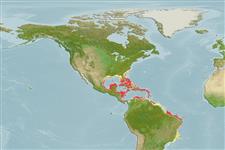Common names from other countries
Environment: milieu / climate zone / depth range / distribution range
Ecologie
marien rifbewoner; diepte 1 - 60 m (Ref. 9710), usually 1 - 40 m (Ref. 27115). Tropical; 22°C - 27°C (Ref. 27115)
Western Central Atlantic: Bermuda, Bahamas, and Central America to northern South America.
Lengte bij maturiteit / Grootte / Gewicht / Leeftijd
Maturity: Lm ?, range 3 - ? cm
Max length : 8.0 cm TL mannelijk / geslacht onbekend; (Ref. 7251)
Dorsale stekels (totaal) : 12; Dorsale zachte stralen (totaal) : 10. Bicolored: purple (appearing blue underwater) in front, bight orange-yellow behind (Ref. 26938).
Often found in caves or under ledges. Swim with belly toward substratum, thus under ledges seen upside down. Feed on ectoparasites of other fishes (Ref. 5521). Males show various types of nest care behavior (Ref. 35580). Retreat into recesses when alarmed (Ref. 9710). Have been reared in captivity (Ref. 35420).
Mouthbrooding in this specimen has not been supported by any evidence (Ref. 35580). Prior to spawning, some males established nest sites, using small holes and crevices in the substratum. Females traveled to male nests for egg deposition around dawn. Eggs deposited within the nests were tended by males that established the nests. Males display four types of nest care behaviour: guarding, nest maintenance, detritus clearing,and simple nest entering (Ref. 35580).
Asoh, K. and T. Yoshikawa, 1996. Nesting behavior, male parental care, and embryonic development in the fairy basslet, Gramma loreto. Copeia 1996(1):1-8. (Ref. 35580)
Status op de Rode Lijst van het IUCN (Ref. 130435)
CITES (Ref. 128078)
Not Evaluated
Gevaar voor de mens
Harmless
Gebruik door de mens
Visserij: commercieel; Aquarium: Commercieel
Tools
Speciale rapporten
Download XML
Internetbronnen
Estimates based on models
Preferred temperature (Ref.
115969): 25.1 - 28, mean 27.1 (based on 436 cells).
Fylogenetische diversiteitsindex (Ref.
82804): PD
50 = 0.5313 [Uniqueness, from 0.5 = low to 2.0 = high].
Bayesian length-weight: a=0.01122 (0.00514 - 0.02450), b=3.04 (2.87 - 3.21), in cm Total Length, based on all LWR estimates for this body shape (Ref.
93245).
Trofisch niveau (Ref.
69278): 3.3 ±0.41 se; based on food items.
Fishing Vulnerability (Ref.
59153): Low vulnerability (10 of 100).
